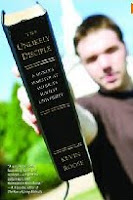Book:
The Five Most Important Questions You Will Ever Ask About Your OrganizationBy Peter Drucker, with Jim Collins, Philip Kotler, James Kouzes, Judith Rodi, V. Kasturi Rangan, and Frances Hesselbein
(Notes are from the AudioTech Book Summary)
Explore….the five simple, yet essential questions first posed by Peter F. Drucker, who is widely considered to be the world’s foremost pioneer of management theory. (In this issue column)
Analyze….your organization’s mission, which should be a short, sharply focused statement that tells everyone why you do what you do, not how you do it. (In this issue column)
Assess….who your target customers are, who and what influences them, what they value, how you can create satisfying experiences for them, and which customers you should stop serving. (In this issue column)
Determine….what specific results your organization should be striving to achieve, and where you should focus for future success. (In this issue column)
Develop….your organization’s plan, which must define the particular place you want to be as well as the budget and action steps that will enable you to get there. (In this issue column)
These five simple questions will help you to assess what you are doing, why you are doing it, and what you must do to improve the organizations performance. (page 1)
What is our mission?
Who is our customer?
What does our customer value?
What are our results?
What is our plan?
The questions then guide you through the process of assessing how well you are doing, ending with a measurable, results-focused strategic plan to further the mission and to achieve the organization’s goals, guided by the vision. (page 1)
The ultimate beneficiaries of this very simple process are the people or customers who are touched by your organization and by others like you who have made the courageous decision to look within yourselves and your organization, identify strengths and challenges, embrace change, foster innovation, respond to customer feedback, look beyond the organization for trends and opportunities, and demand measurable results. (page 2)
The danger is in acting on what you believe satisfies the customer. (page 2)
All the first-rate decision makers that Drucker observed had a very simple rule: If you reach consensus quickly on an important matter, don’t make the decision. A fast agreement means nobody has done the homework. The organization’s decisions are risky and important, and they should be controversial. (page 2)
Every organization needs a healthy atmosphere for dissent if it wishes to foster innovation and commitment. Open discussion uncovers what the objections are. (page 2)
Self-assessment should convert your mission and your knowledge into effective action – not next year, but tomorrow morning. (page 2)
Question 1: What is Our Mission? (page 3)
A mission cannot be impersonal. It has to have deep meaning, be something you believe in – something you know is right. A fundamental responsibility of leadership is to make sure that everybody knows the mission, understands it, and lives it. (page 3)
An effective mission statement is short and sharply focused. It should fit on a T-shirt. The mission says why you do what you do, not the means by which you do it. The mission is broad, yet directs you to do the right things now and into the future so that everyone in the organization can say, “What I am doing contributes to the goal.” It must be clear, and it must inspire everyone to say, “Yes, this is something I want to be remembered for.”
Demographics change. Needs change. You must search out the accomplished facts – things that have already happened – that present challenges and opportunities for the organization. Leadership has no choice but to anticipate the future and attempt to mold it. (page 3)
The question of mission has become even more important as our world becomes increasingly disruptive and turbulent. (page 3)
Every truly great organization strives to preserve the core mission, yet stimulate progress. The core mission remains fixed while operating practices, cultural norms, strategies, tactics, process, structures, and methods continually change in response to changing realities. It is the glue that holds an organization together as it expands, decentralizes, globalizes, and attains diversity. (page 4)
In fact, the great paradox of change is that the organizations that best adapt to a changing world first and foremost know what should not change. They havea fixed anchor of guiding principles around which they can more easily change everything else. They know the difference between what is truly sacred and what is not, between what should never change and what should always be open for change, and between “what we stand for” and “how we do things.” (page 4)
One cautionary note: Never subordinate the mission in order to make money. If there are opportunities that threaten the integrity of the organization, you must say no. Your mission provides guidance, not just about what to do, but equally about what not to do. (page 5)
Keep the first question – What is our mission? – in front of you throughout the self-assessment process. Step by step, you will analyze challenges and opportunities, identify your customers, learn what they value, and deliver your results. When it is time to develop the plan, you will take all that you have learned and revisit the mission to affirm or change it. (page 6)
…..start with the long range and then feed back and say, “what do we do today.” The ultimate test is not the beauty of the mission statement. The ultimate test is your performance. (page 6)















